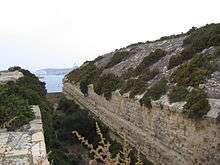Polygonal fort
_01_ies.jpg)
A polygonal fort is a fortification in the style that appeared in the end of the eighteenth century and evolved around the middle of the nineteenth century, in response to the development of powerful explosive shells.
The complex and sophisticated designs of star forts that preceded them were highly effective against cannon assault, but proved much less effective against the more accurate fire of rifled guns and the destructive power of explosive shells. The polygonal style of fortification is also described as a "flankless fort". Their low profile makes them easy to overlook.
One of the earliest polygonal forts in the world is Fort Tigné on Tigné Point, Malta, which was built by the Order of Saint John between 1792 and 1795.[1] After the British took Malta in 1800, they considered this fort as the "perfection of a small fort without flanks ... capable of considerable resistance", and the British built a battery on Anholt (1812) and a fort on Vido (1824) in a similar design. The British went on to build several other polygonal forts and batteries on Malta from 1872 to 1909, the first one being Fort St. Rocco.[2]
Many were also built in the United Kingdom during the government of Lord Palmerston, and so they are also often referred to as Palmerston forts.
In response to the vulnerabilities of star forts, military engineers evolved a much simpler but more robust style of fortification.

The ditch became deep and vertical sided, cut directly into the native rock. It was laid out as a series of straight lines surrounding the fortified area that gives this style of fortification its name.

The ditch was swept by fire from defensive blockhouses (caponiers) set in the ditch, and firing positions cut into the outer face of the ditch itself (counterscarp battery).
The profile of the fort becomes very low indeed, surrounded outside the ditch by a gently sloping open area (glacis), so as to provide no protection for an enemy while the fort itself provides a minimal target for enemy fire, and the narrow ditch a difficult target for plunging shellfire.
The counterscarp, (the outside of the ditch) is usually vertical, while the upper edge of the scarp is steeply sloping and often revetted in stone, to help shed shells into the ditch.
Access to the fort was down a curving ramp cut into the glacis, then through a gatehouse set deep in the scarp of the ditch, reached by a rolling bridge that withdrew into the gatehouse.

The majority of the fort is underground, with deep passages giving access to the counterscarp batteries and the ditches defensive blockhouses (caponniers) from within the fort.
Magazines and machine halls are deep under the surface, with only the emplacements for the fort's guns exposed at the surface.
Perhaps surprisingly the guns were often mounted in open emplacements, known as "en barbette", simply protected by a parapet. This was not only to lower the outline of the fortress, but also because guns of this period were rifled muzzle loaders (RML), still using black powder as their propellant, which generated large amounts of fumes and smoke.
Because of the fast burning propellant, gun barrels were short, and accuracy still relatively low. Experience had shown that guns could be put out of action by collapsing their casemates around them by bombardment. The gun in its open emplacement was a much harder target to hit than the massive face of a casemate.
The polygonal forts provided robust and defendable gun platforms. They were built in the context of a larger defensive scheme, as forward batteries to engage the enemy and prevent them bombarding more vulnerable targets, like city rail centres and dockyards.
Forts of this style were built extensively from the middle of the nineteenth century, but the end of the century saw the development of slower burning propellants, which allowed longer guns with much better range and accuracy and that produced much less smoke, and this along with the increasing reliability of breech-loading guns, favoured fortifications completely underground except for massive steel cupolas containing the guns.
The increasing range of field artillery also required corresponding increases in the depth of zone that forts needed to prevent bombardment of the resources being defended.
Meanwhile, the development of machine guns and barbed wire offered a more flexible and much cheaper means of protecting from infantry assault compared to the polygonal fort's ditches and blockhouses.
Many of the polygonal forts in Malta continued in service, even through the Second World War, since they provided convenient strongpoints, and their open emplacements readily accepted anti-aircraft batteries and quick firing guns, but the art of fortification had moved on.
In Malta, two polygonal forts, Fort Mosta and Fort Madalena, are still in use by the Armed Forces of Malta, the former being used as an ammunition depot and the latter housing part of the Communications Information Systems Company of the AFM.[3]
References
- ↑ Spiteri, Stephen C. "Fort Tigne - 1792-95". MilitaryArchitecture.com. Retrieved 2 January 2015.
- ↑ Spiteri, Stephen C. (22 November 2010). "Fort St. Rocco". MilitaryArchitecture.com. Retrieved 23 December 2014.
- ↑ "3rd Regiment, AFM". Armed Forces of Malta. Retrieved 2 January 2015.